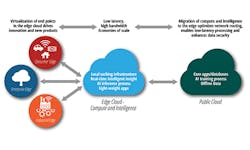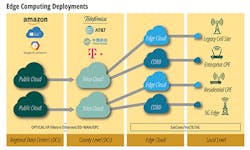Latest from C&E/NetDev Ops/GIS/Open-Source Networks
A $54B Opportunity by 2020 Awaits —
Demand for online services has grown substantially and has been driven by new Internet users, higher consumption of video content, and the emergence of cloud services. Consumers are becoming more mobile and more connected, and they expect a digital experience wherever they go. More than ever, compute and intelligence (artificial and machine) ought to be as close to consumers as possible. This marks a departure from the central repository or workload that predominates the telco world of today. The likes of Amazon, Google, and Netflix, already predicate their business model on their widely diffused edge infrastructure known as Content Delivery Networks (CDNs). This is a trend that is now picking up pace in telecoms, where there is increased market activity to place intelligent agents as close to the "edges" as possible.
Mobile Service Providers (MSPs) are centralizing telecoms infrastructure in their private clouds, and at the same time, trying to understand how they can deploy edge computing across their networks. The impending commercialization of "telco edge" constitutes a "white space" opportunity that will usher in significant growth for both the supply and demand side in telecoms, finds global tech market advisory firm ABI Research. There are a handful of new emerging applications, including autonomous driving, industrial use cases, Augmented and Virtual Reality, and Artificial Intelligence (AI) that require distributed processing capabilities that only edge computing can offer.
A Distributed Telco Edge Architecture (Sources: ABI Research)
Multiple strands, however, need to be addressed before edge computing becomes mainstream. There are various layers of edge deployment types, but not a one-size-fits-all commercial model. This not only renders the management of edge products a challenge but also presents a commercial opportunity for edge deployments and 5G rollouts. There are some promising market engagements from MobiledgeX and ori.co — 2 new and disruptive entrants that aim to monetize 5G networks and associated edge deployments in telecoms. Meanwhile, MSPs like AT&T and Telefónica are advancing in their journey to unlock the power of edge computing to deliver new services over 5G networks.
InvisiLight® Solution for Deploying Fiber
April 2, 2022Go to Market Faster. Speed up Network Deployment
April 2, 2022Episode 10: Fiber Optic Closure Specs Explained…
April 1, 2022Food for Thought from Our 2022 ICT Visionaries
April 1, 2022In business, as in most other undertakings, nothing starts big: tomorrow’s whale is today’s minnow. The challenge for the industry is that today’s minnows are tomorrow’s meals, and knowing which is which is not easy. The impending market for telco edge solutions is no doubt tomorrow’s whale, but it is one that is composed of a plethora of piece parts (technologies) that the industry must intimately understand. Currently, all the answers aren’t known, but we ought to understand the choke points in the near term to obtain growth in the long run.
MSPs need a clear sense of the industry(ies) they currently serve, and the additional opportunities that fall within the boundary of telco edge. Caution, however, must be exercised so that well-defined boundaries do not obstruct the path to "white space" telco edge opportunities. At present, MPSs are in limbo. They understand the edge holds great potential, but they don’t yet know how to make money out of it. They need a "hero" edge application to kick start this market. Moreover, if the telecom industry aims to mirror the degree of nimbleness and commercial "flatness" that webscale providers enjoy, it may need to sidestep the time-consuming standardization approaches that predominate today.
Figure 2. Edge Computing in Telco Networks (Sources: ABI Research)
Telco edge constitutes a growth opportunity, but MSPs must realize that capturing this growth is not a quick endeavor. It will take time. But that should not preclude the industry from making a step now and accelerating efforts at some point down the line. MSPs should recognize what current telco platforms can offer today and deploy them without waiting for mature and proven solutions. Edge solutions from major cloud players (e.g., Microsoft Azure IoT Edge, Amazon’s AWS IoT Greengrass) may have the upper hand in technology maturity. But, MSPs retain advantage at the edge with assets such as spectrum, central office, base stations and billing relationships, all of which are hard to imitate capabilities. The ability to move at cloud pace can be obtained with the right alliances and partnerships and an ecosystem that extends the utility of IT-designed solutions to the telecom domain.
One key concept that applies to both vendors and MSPs is the ability to understand and prioritize how to build edge infrastructures that align with the ultimate business goal. ABI Research’s forecast indicates that the penetration of edge servers in telco infrastructure stands to create a US$54 billion opportunity by 2024. The value to various telecom vendors and software solution providers will vary in line with their ability to help MSPs capitalize on the revenue potential of key use cases such as video caching, geo-specific, and personalized services.
In the long run, telco edge deployments will become the de facto platforms to deliver services close to end users and enterprise facilities. 5G and edge are partner technologies, and in the long term neither can become truly profitable without the other. But, the operators must identify both the enterprise vertical to prioritize and the ideal position of their edge servers. If they don’t do this immediately, Amazon, Google, and Facebook, will target the very same enterprise verticals MSPs are trying to address. This will seriously devalue 5G and the future of mobile service providers in general.
These findings are from ABI Research’s Telco Edge: Enabling Technologies and Commercial Analysis technology analysis report. Additional research highlights include:
• Vendors should bring to market telco edge solutions that are conducive of a platform-first approach. The goal is to have simplification and rationalization of silos with an integrated system so that any application can run on any cloud infrastructure (multi-cloud) and connect any device.
• Vendors should provide an open framework than enables interoperability and scale. Prospective telco edge solutions should be interoperable with Application Programming Interfaces (APIs) across public, private, telco and hybrid clouds, as well as emerging clouds at the edge. Further, full network automation is key to proactively optimizing network resources, guaranteeing end-to-end service level availability, and ensuring rich operations telemetry for cross-platform visibility and troubleshooting.
• MSPs must adopt a phased approach to edge architectures, 5G, and, by extension, virtualized architectures. Some MSPs have already deployed cloud and virtualized operations for 4G, so they are in a good position to move into telco edge and 5G. Those MSPs making the jump now should decide what the priority services are and move them into virtualized environments.
• MSPs must seek the right partnerships and alliances to seek new edge revenue models. Partnerships and alliances that offer cross-operator capabilities are being considered as a very promising development. Furthermore, MSPs should not underestimate the organizational, cultural, and process transformation required so that they can take full advantage of edge platforms and 5G networks.
Like this Article?
Subscribe to ISE magazine and start receiving your FREE monthly copy today!
This report is part of the company’s 5G Core & Edge Networks research service, which includes research, data, and Executive Foresights. Based on extensive primary interviews, Technology Analysis reports present in-depth analysis on key market trends and factors for a specific technology.











